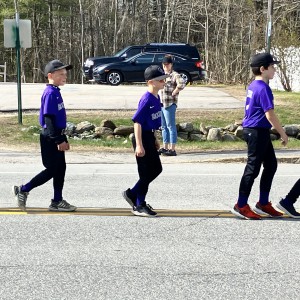Fall is prime time for bird-watching at Miller State Park
| Published: 10-04-2023 10:14 AM |
For birdwatchers or anyone looking for views of fall foliage, the twisting, hairpin-filled drive up Pack Monadnock at Miller State Park is a destination.
Starting on Sept. 1 through about Nov. 20 every year, biologists from the Harris Center for Conservation Education in Hancock staff the Raptor Observatory at the state park, recording the fall migration of raptors down the Eastern seaboard. The Harris Center has been tracking numbers and compiling data about raptor migration, which are a good indicator of environmental health, for more than a decade.
Harris Center biologist Phil Brown said Tuesday that numbers of migrating raptors, mainly broad-winged hawks, are above average for this year.
“We’ve had some incredible days this year where we’ve seen thousands of hawks all at once, just swirling above us,” Brown said. “It’s just amazing when people get to see that, especially school groups. We’ve already counted over 10,000 hawks for this season, which is about 75% of what we usually see, and we’re not even at the halfway point of the watch.”
Brown noted that skies were hazy on Tuesday as a result of forest fire haze drifting down from Lake Huron, which limited visibility, and that it was a slow day for migration.
“It all depends on the wind. The birds use thermals to migrate, so they can just glide, save their energy and go farther. Some of the raptors travel as far as 250 to 300 miles in a single day,” Brown said. “The broad-winged hawks are going all the way to South America; the ospreys need to find fish through their whole migration. They all take slightly different paths and have different destinations.”
Jane Charlesworth of Bedford brought her sister, Judy Pease, who was visiting from Kansas City, to the observatory in hopes of glimpsing raptors on the go.
“My sister is an expert birder, so this is just fantastic for her. And what a day to be up here. It’s perfect!” Charlesworth said.
Article continues after...
Yesterday's Most Read Articles
 Superintendent Kimberly Rizzo Saunders leaving ConVal School District
Superintendent Kimberly Rizzo Saunders leaving ConVal School District
 PHOTOS: Peterborough hosts Children and the Arts celebration
PHOTOS: Peterborough hosts Children and the Arts celebration
 Vehicle rolls over on Route 31 in Greenfield
Vehicle rolls over on Route 31 in Greenfield
 Peterborough voters approve funds for fire and rescue station
Peterborough voters approve funds for fire and rescue station
 Mt. Monadnock Little League celebrates opening day
Mt. Monadnock Little League celebrates opening day
 Meg Gourley – Village improvement societies do what needs to be done
Meg Gourley – Village improvement societies do what needs to be done
Caroline Wawrzynowski of Manchester asked Brown about monarch butterfly migration.
“We have not seen a lot of monarchs this year. Numbers of migrating monarchs has been very low, which reflects the declining monarch population due to deforestation in Mexico, where monarchs spend the winter, loss of milkweed and effects of climate change,” Brown said.
The observatory is a busy place, with school groups coming from throughout the Monadnock region and from out of state. About 30,0000 students, ranging in age from preschool through ornithology students from Antioch University New England in Keene, visit the each year.
“We love talking to the kids. The amount of negative information about the environment can be really overwhelming, and we always want kids to feel hope. We always want them to know they can make a difference, so we always give them a positive message, a hopeful message. We always tell them about solutions,” Brown said.
This year, biologists, visitors and volunteer observers have recorded kestrels, merlins, ospreys, peregrine falcons and turkey vultures, as well as 100 bald eagles, among other raptors.
The observatory is located on a platform just off the Wapack Trail, about a five-minute downhill walk from the parking lot at the top of Miller State Park. The observatory is staffed from 9 a.m. to 5 p.m. every day, and entrance to Miller State Park is $4 for both drivers and hikers.
On Saturday, Oct. 7, the observatory will host the “Big Sit,” a special event for World Migratory Bird Day hosted by Harris Center raptor biologists Levi Burford and Katrina Fenton. The event is 10 a.m. to 4 p.m. and registration is required. To register, go to harriscenter.org/events/birding-for-all-world-migratory-bird-day-big-sit-at-pack-monadnock.















 Learn about summer activities with Staycation
Learn about summer activities with Staycation Grange recognizes town’s top citizens
Grange recognizes town’s top citizens New Ipswich Planning Board allows up to 29 lots for proposed subdivision
New Ipswich Planning Board allows up to 29 lots for proposed subdivision
